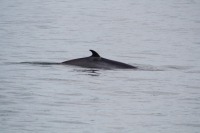
(Photo: Tracey Dean)
Northern Minke Whale
Balaenoptera acutorostrata
The smallest baleen whale. Average length is 8.2 metres and average weight is 9 000 kilograms. They have a dark back (black, grey, bluish). Their underside is white with whorls of white often extending to behind the pectorals. Their curved fin is two-thirds of the way back on its body. They have two blowholes and emit a small blow that is rarely seen but sometimes smelled, giving rise to the name stinky minke.
Authority
Lacépède, 1804
Classification Details
Phylum: Chordata (chordates); Subphylum: Vertebrata (vertebrates); Class: Mammalia (mammals); Infraorder: Cetacea (whales and dolphins); Superfamily: Mysticeti (baleen whales).
Habitat
This species is found in all ice-free waters of the world's oceans, from the tropics to the poles. Scientists used to think that all minke whales were the same species. However, taxonomists have recently classified the Antarctic minke whale (Balaenoptera bonaerensis) as a separate species. Three subspecies are now also recognized within the northern minke. North Atlantic minke populations migrate to the Caribbean between November and May. They return to northern waters to feed in the summer. They tend to be solitary, though are sometimes seen in pairs or small groups.
Diet
A predator, feeding on krill and small fish. Their most common prey capture method is lunge feeding. The whale lunges at the prey, often at high speeds, with its mouth open and throat grooves extended. It then closes its mouth and expels the water through its baleen plates. The trapped prey is then swallowed.
Reproduction
Sexes are separate. They reach sexual maturity at around seven or eight years old. They mate in late winter and gestation is 10 months. They give birth to one calf every 12 to 24 months. Calves are three metres when born and nurse for around six months. The reproductive cycle of this whale is poorly known and there are no identified calving waters. They are thought to live to around 50 years old.
Fun Facts
The name for this species comes from an 18th century Norwegian whaler named Meincke.
Orcas (killer whales) feed on minke whales; in one study, scientists found 84% of orca stomachs contained minke. They seem to favour the minke's jaw and tongue particularly.
References
Eder T (2012) Whales and Other Marine Mammals of Atlantic Canada. Vancouver: Lone Pine Publishing. Ingram SN, Walshe L, Johnston D, Rogan E (2007) Habitat partitioning and the influence of benthic topography and oceanography on the distribution of fin and minke whales in the Bay of Fundy, Canada. Journal of the marine biological association of the United Kingdom 87, 149–156. MarineBio. Minke Whales, Balaenoptera acutorostrata. https://marinebio.org/species/minke-whales/balaenoptera-acutorostrata/ Consulté en ligne le 19 janvier 2020. Perrin WF (2020). World Cetacea Database. Balaenoptera acutorostrata Lacépède, 1804. Accessible via : World Register of Marine Species at: http://www.marinespecies.org/aphia.php?p=taxdetails&id=137087 Consulté en ligne le 19 janvier 2020.

